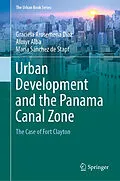The construction of the Panama Canal at the beginning of the twentieth century created an enclave that ran parallel to the interoceanic waterway, controlled by the US government: the Canal Zone. This book aims to understand the implications that Panama Canal Zone urban planning had on human health, natural resources, and biodiversity through the study case of Fort Clayton, highlighting how the sanitary concerns shaped building regulations and the urban landscape of towns.
Autorentext
Graciela Arosemena Díaz, Ph.D., is currently a Professor at the University of Panama in the Department of Planning in the School of Architecture and is a member of the National System of Research (Sistema Nacional de Investigación). She combines teaching and research projects on urban sustainability and landscape. She is an architect and received her Master of Science degree in Urban Environment and Sustainability and her Ph.D. in Energy and Environment in Architecture, both from Universidad Politécnica de Cataluña (Barcelona Tech). She is the author and co-author of books and articles on landscape and urban sustainability.
Almyr Alba, M.Sci., is an architect and a historic preservation specialist, is currently Professor at the University of Panamá, in the School of Architecture. Her research, publications, and conservation practice have contributed to the conservation of several historic sites at Panama. Alba received her Master of Science degrees from theUniversity of Pennsylvania with emphasis in architectural conservation under the auspices of a Fulbright scholarship.
